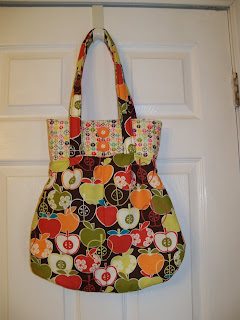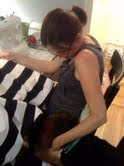My friend Mandy has been working on redecorating her apartment for some time now, and as one component of that process, decided she wanted to put up a curtain between her kitchen and her dining area, which are separated by a wide opening rather than a regular doorway. When she decided to host a Afternoon Tea (for my birthday party, actually) in her apartment, that put a timeline on getting those curtains installed.
She loved the look from this picture, which she saw on the blog "
Live Creating Yourself."

So this acted as her inspiration for the look she wanted to create, and originally she looked for curtains that had this wide black and white stripe. When that search failed, "Plan B" was "We can get the fabric and just make the curtain." Since I'm the one who knows how to sew, "we" meant me :)
Mandy found this perfect fabric at
IKEA (they actually have a really great selection of household fabrics there) -

And I went to work measuring, cutting, ironing, pinning, and sewing. Mandy helped with the ironing and pinning of the seams. Here are some "action" pictures of the making of the curtains:
It was quite a production to make these curtains. I don't think I've ever made full length curtains before this, and I was very nervous that they wouldn't come out right, wouldn't hang the way she wanted them to at the top, or just wouldn't be perfect. We measured floor to ceiling multiple times, and then I drew out a sketch of the measurements, planning for the seams and also for the "pocket" at the top, but somehow, I still managed to over-calculate the length, and I had to cut 5 more inches off the bottom after I thought I was done and re-hem the bottom seam.
Mandy wanted the curtains to hang across a wire that she also bought at IKEA (more about installing this wire later), and to have a gathered / pleated look rather than hanging straight across. The fabric we found was only a few inches shorter in width than the opening / doorway. We bought enough yardage, therefore, for two panels, giving enough width to really bunch or gather the top the way she wanted.
The side seams on each panel were one inch seams, double creased (meaning we creased one inch in, then folded over again and creased with the iron). The bottom seam was a little over one inch, also double creased.
For the top "pocket" I wanted it to have a seam at the top with at least an inch of fabric above the seam, and then a wide enough pocket that if she chose to use it on a pole later rather than the wire, it would still fit. The pocket itself was 3.5 inches, and the top seam above that was one inch. So to do this, I first made a one inch single crease at the top of the fabric all the way across. I then folded it down about 5 inches down. I then hemmed the fabric first across the bottom, in the middle of where the folded piece was now tucked under, to make the bottom seam of the pocket; then made a seam across the top of the panel, about one inch in.
Almost done:
Then came the hard part. Because these curtains were being hung across the top of a wide opening, regular curtain rods would not work. Mandy found these
curtain wires at IKEA that allow for more flexibility in terms of where they attach to the wall:

If you assume this thing is simple, you'd be wrong! So the process is to attach the hardware at one end where you want it to be (which took some trial and error in terms of what kind of screws actually went into the wall in her apartment), and then you insert this wire into a hole at the end of the hardward, and tighten these tiny little keys (those tiny little screw-looking things) into it to hold onto the wire. Then you pull the wire across to the other side, where you have also attached hardware, and after a very complicated measuring and cutting process (which would have been easier had we had the right wire cutters), you insert the wire into that end, tighten the keys, and then tighten the hardware itself to pull the wire taut. As if this process wasn't complicated enough (and believe me, my description of it sounds a lot simpler than the real life version; let's face it, I just don't want to relive the horror it actually was by truly describing it in detail to you!) - our process was complicated further by the fact that we had to put the curtains onto the wire first. Otherwise, how would one get those curtains on that wire? IKEA leaves this out of its instructions, I guess assuming you'll use curtain clips or something, although I swear when I saw it in the store the curtain was actually hanging on the wire too. In any event, Mandy didn't want clips, and so we had to figure it out. It involved one of us standing on a chair bearing the weight of the curtains and attempting to hold them so that the wire was as close as possible to being straight across the room; the other standing on a ladder with the tools, trying to force the mutilated end of the wire into the tiny hole and tighten everything without losing the key; both of us sweating and cursing and more and more irritable about the whole thing. It took a few hours, honestly. I'm sure someone out there has a post on some other blog or whatever about how simple these things aren't, and maybe we were just doing something wrong, but it was really a nightmare. Finally, in the middle of the night, the curtains were up!
And here is the finished product:

While I was making these curtains, Mandy also needed a new tablecloth. Her dining table is a round table for four, but it has an extra leaf you can put in to make it a 61" long oval table, which she needed for the Tea Party.
She also found fabric at IKEA for this project:

This was much easier to do, of course. I just measured and cut so that there would be about a 5" to 6" drop on all sides, then did a 3/4" double creased seam and hemmed it all around, tucking in or "mitering" the corners for a cleaner look.
Here is the finished tablecloth:
When it was all done and together, it looked fabulous, very sophisticated and modern. Mandy's vision for this room was perfect. I never would have believed that a big curtain hung to cover an opening between rooms would make a space look bigger rather than smaller, but it really does. The dining room is now it's own separate entity and somehow seems much more spacious than it was before. The simple black and white made a nice addition to her room, which has black and white furniture (a white table with black chairs), very colorful "gallery style" wall art on two sides, and a beautiful brightly colored chandelier from Urban Outfitters. Here are some more pictures of the room:








































